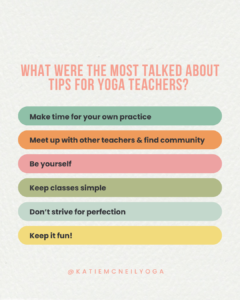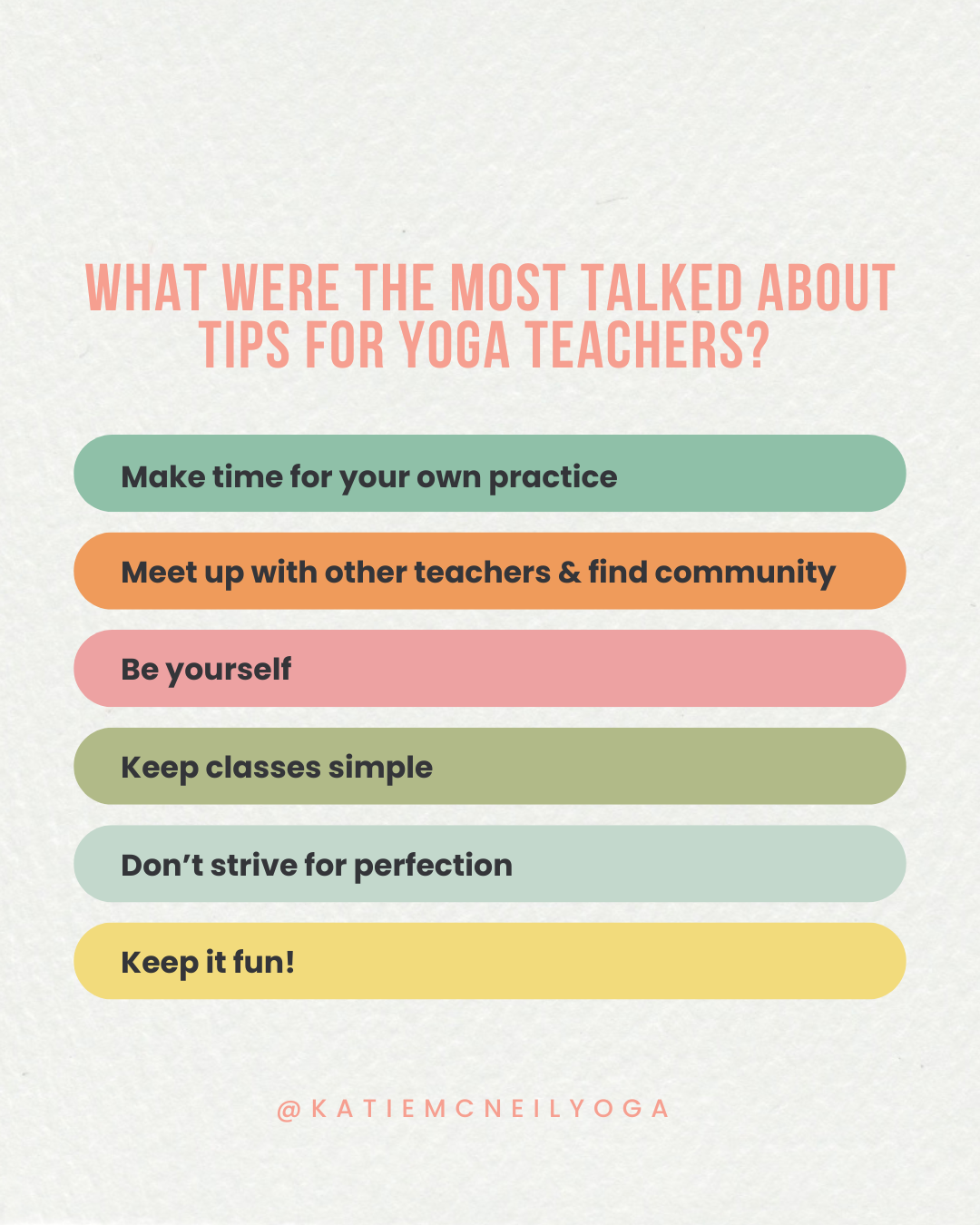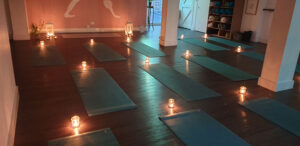Tips for yoga teachers
I am starting this post with a really big thank you to all the people who contributed to this by completing the survey. Thank you for taking the time to pause and share your thoughts on the topic.
Are you new to teaching yoga? Or perhaps you're an experienced teacher looking to reflect on shared insights from fellow instructors?
Some time ago—longer than I'd like to admit—I sent out a survey to yoga teachers to gather their thoughts, experiences, and advice for new instructors. The question at the heart of it was simple: “What tips do you have for new yoga (or other movement) teachers?”
Why did I do this? Because it’s one of the most common questions in the yoga teaching community that I get asked from new teachers. And when you talk to teachers—whether they’re fresh out of training or have been teaching a while—you uncover so many valuable, nuanced lessons that could be incredibly helpful to those just starting out. Wouldn’t it be great to have all these insights in one place? To spark conversations, encourage new ways of thinking, and foster support within our teaching community?
So here we are, many months later, diving into your responses. (By the way, the survey is still live! I'll continue updating this blog with new insights, so if you'd like to contribute or read the original post, you can find it [here].)
How long after graduating did you start teaching?

Out of the 15 responses so far, 11 people dived straight into teaching, one person started teaching after about two months, and three people started teaching after about a year.
The most common advice? Start as soon as you can. Here are some words of wisdom from fellow teachers:
“Teaching is much like driving a car—you don’t really start learning until you’re out there doing it. You won’t be perfect, it might take time to find your voice, and you’ll have bad days just like anyone else. But you just have to do it. Try, fail, get up, and go again.”
“Teach family and friends as soon as possible after training. It helps consolidate your learning while it’s fresh, and a friendly audience can ease the nerves.”
“Don’t wait for the ‘perfect time’ or until you ‘know everything’—the time is now.”
“You learn so much from your students that you can’t get from books or training alone. Start teaching, and the learning will follow.”
“I started with family and friends while still in training. It helped me develop my teaching style and find my voice.”
Starting can feel daunting. Even after teaching friends and family, my first public class at a local studio had me super nervous. I remember one of my mentors, Harriet, suggesting I write down and tick off my first 20 classes. I did, and it helped so much. I rewarded myself after those 20 classes (even though they were mostly a blur of nerves and stumbles!). Over 2,000 classes later, I still think about that chart beside my bed where I counted down those first few steps into teaching. Celebrate the moments where you feel proud teaching.
What tips do you have for new yoga (or other movement) teachers?

Recurring Themes from the Survey
1. Prioritize Your Own Practice
Your teaching is only as strong as your connection to your own practice. This doesn’t mean rigid discipline; it means making time for your mat in whatever way supports you—whether that’s self-practice, attending other teachers' classes, or simply sitting in stillness. And if your practice slips, meet yourself with kindness and return when you're ready.
2. Find Community
Yoga teaching can be lonely. Many of you emphasized the importance of connecting with other teachers—through peer support spaces, mentorships, or just casual chats over coffee. Having a place to ask questions, share experiences, and support one another makes a world of difference.
3. Be Yourself
“The more of yourself you bring to teaching, the more you’ll find ‘your’ students—those who resonate with you. If you’re a goofball, let it out. Nobody is perfect, so don’t try to be—it’s exhausting. But also, be mindful of boundaries. Teaching is already a vulnerable space, for both teachers and students, so keeping yourself and your students safe is essential.” – Hannah
It takes time to get comfortable in front of a class. But as you find your feet, let your authenticity shine through—it will make your teaching more natural and enjoyable.
4. Keep It Simple
Even now, I still catch myself over-planning classes, only to leave half of it out. The best advice? Teach what you know. Keep it simple. Yoga isn’t about complexity; your students are there because they enjoy the practice. Let go of the pressure to craft elaborate sequences—sometimes the simplest classes are the most profound.
5. Embrace Imperfection
What even is perfect? It’s okay to say left when you mean right. It’s okay to forget your sequence or wobble in a pose. Your students don’t need you to be perfect—they need you to be real. And when you embrace your imperfections, you give them permission to do the same.
6. Keep It Fun
Let yourself enjoy teaching! The more joy you bring, the more your students will feel it.
Common Teaching Mistakes (And What We Can Learn from Them)
Mistakes happen—they always will. But reflecting on them can help us grow. Here are some of the mistakes you shared:
“Not having a clear cancellation policy. Letting people cancel last minute and reschedule led to so much extra admin work.”
“Taking it personally when students didn’t like my class.”
“Not clarifying what kind of adjustment I was giving in Savasana—one student expected a foot press and got a shoulder press instead! Now I always ask for explicit, ongoing consent.”
Consent is a huge topic in yoga teaching—something I’ll dive into another time. But for now, ensuring consent is informed, explicit, and continuous is essential. There are practical things you can do to help gain consent if you are thinking about offering adjustments/assists.
It can be really hard to not think everyone is angry at you when people are mid warrior pose. They are likely not angry at you, they are deep in the practice and have no idea they are frowning at you. And if they don’t like your class, that is fine, other people will, and you really don’t have to please everyone.
Oh the many admin things we can do to help our future selves out is a long list. Cancellation policies are great, along with waiver data protection policies. All the things that mean you have a process. It might take a while to set up, but ask other teachers, and they will likely be happy to share their template with you.
Tech Tools for Yoga Teachers
A few of the tech recommendations you shared:
- Google Docs – For storing sequences, workshop outlines, and invoices, for making template - oh, and writing blogs!
- Read Books - It doesn’t always have to be an expensive training course, slowing down to read over a yoga book can be just as beneficial sometimes. There is also a yoga book club over at Vishuddha Yoga Centre if you are in Oxford.
- Spotify – For playlists (remember to check licensing!)
- Zoom – For online classes
- Canva – For creating social media posts and advertising
- Bluetooth Speaker – A portable speaker like Wonderboom 2 is a game-changer
- Sup up for taking payments
- Momoyoga or Momence – For class bookings and scheduling
- Insight Timer – For music and meditation tracks
- Rode Wireless Go Mic – If you’re teaching online
The Most Supportive Thing for Your Well-being as a Teacher
One of the strongest messages that came through the survey was the importance of support and self-compassion. Many of you emphasized the power of community—connecting with other teachers for support, mentorship, or just shared experiences.
“Reflect on your teaching without judgment. Take time to acknowledge what went well, not just what you want to improve. Congratulate yourself after each class.”
“Taking a break from teaching—either stepping off the mat entirely or attending someone else’s class—has been essential for my well-being.”
“Other teachers. Having people to talk to, to relate to, to ask questions to. Also to practice with, I love going to other people’s classes. Oh and learning to take time off.”
“Having peer support from a fellow 200hrs graduate”
If you've read this far and want to see more, you can access the anonymised survey responses [here].
I hope this post has been useful and has sparked some connections with fellow teachers. Most responses so far are from teachers in Oxford, but a few are from further afield—perhaps you know them in person or online. Maybe this post will inspire you to reach out and connect.
I’ll leave you with this final thought from Sarah:
“Trust yourself, your students, and the practice.”
If you have ideas for future topics or are a researcher interested in collaborating, feel free to reach out: katiemcneilyoga@gmail.com.



